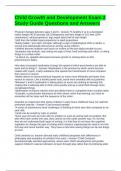-
1. Examen - Assessment quiz - child growth and development exam questions and answers
-
2. Examen - (cgdr) child growth and development exam questions with latest update
-
3. Examen - Cgdr- child growth and development exam questions with latest update
-
4. Examen - Chapter 4 - middle childhood growth and development exam questions with latest update...
-
5. Examen - Chapter 6 "growth and development of the child" exam questions with correct answers
-
6. Examen - Chapter 10 & 11 child growth and development exam questions and answers
-
7. Examen - Chapter 28 growth and development of the school-age child exam questions with correct...
-
8. Examen - Child care professional 1 - lesson 2 child growth and development, part 1 exam questi...
-
9. Examen - Child growth & development- chapter 12 and 13 exam questions and answers
-
10. Examen - Child growth & development exam questions with complete solutions
-
11. Examen - Child growth and development (cgad) exam questions with correct answers
-
12. Examen - Child growth and development (cgdr) exam questions with verified answers
-
13. Examen - Child growth and development cgdr dcf exam questions and answers
-
14. Examen - Child growth and development ch. 1-4 exam questions with correct answers
-
15. Examen - Child growth and development chapter 1 exam study guide questions and answers
-
16. Examen - Child growth and development chapter 1 intro to child development exam questions with...
-
17. Examen - Child growth and development- chapter 2 exam questions and answers
-
18. Examen - Child growth and development chapter 5 exam questions and answers
-
19. Examen - Child growth and development chapter 7 exam questions with latest update
-
20. Examen - Child growth and development chapter 9 study guide exam questions and answers
-
21. Examen - Child growth and development chapter exam questions and answers
-
22. Examen - Child growth and development exam 2 study guide questions and answers
-
23. Examen - Child growth and development exam questions and answers latest update
-
24. Examen - Child growth and development exam questions and answers
-
25. Examen - Child growth and development exam questions and answers
-
26. Examen - Child growth and development exam questions with correct answers
-
27. Examen - Child growth and development exam questions with latest update
-
28. Examen - Child growth and development exam study guide questions and answers
-
29. Examen - Child growth and development final exam questions with correct answers
-
30. Examen - Child growth and development midterm exam questions and answers
-
31. Examen - Child growth and development midterm exam questions with latest update
-
32. Examen - Child growth and development module 1 exam test guide questions and answers
-
33. Examen - Child growth and development module 1 the principles of child growth and development ...
-
34. Examen - Child growth and development module 2-child development theories exam questions with ...
-
35. Examen - Child growth and development module 3 influences affecting child growth and developme...
-
36. Examen - Child growth and development module 4 developmental characteristics exam questions an...
-
37. Examen - Child growth and development module 5 developmental characteristics exam questions wi...
-
38. Examen - Child growth and development module 6 developmentally appropriate practices exam ques...
-
39. Examen - Child growth and development test #1 exam questions with correct answers
-
40. Examen - Unit 1 - child growth and development exam questions with complete solutions
-
41. Examen - Understanding child growth and development exam questions with verified answers
-
42. Examen - Principles of child growth & development exam questions and answers
-
43. Examen - Module 1 princples of growth and development exam questions with latest update
-
44. Examen - Module 1 principles of child growth and development exam questions and answers
-
45. Examen - Module 1 - 6 child growth and development exam questions with correct answers
-
46. Examen - Maternal child growth & development exam questions with correct answers
-
47. Examen - Growth and development questions, answers, rationales exam questions with complete so...
-
48. Examen - Growth and development exam questions with correct answers
-
49. Examen - Eec child growth and development exam questions and answers
-
50. Examen - Child growth and development theories exam questions and answers
-
51. Examen - Child growth and development theories exam questions and answers
-
52. Examen - Child growth and development vocabulary exam questions and answers
-
53. Examen - Dcf - child growth and development exam questions and answers 2024
-
54. Examen - Dcf child growth & development exam questions with correct answers
-
55. Examen - Dcf child growth and development cgad exam questions with verified answers
-
56. Examen - Dcf fl child care (cgdr) child growth and development (2024) exam questions with corr...
-
57. Examen - Early childhood growth and development exam questions with latest answers
-
Mostrar más




